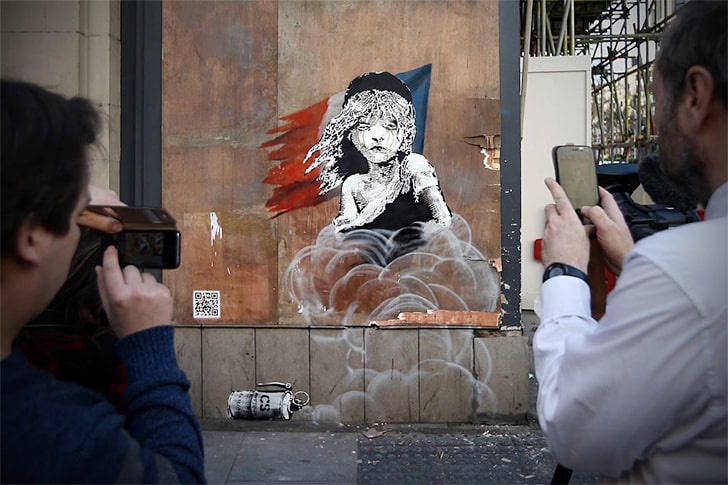
When Banksy unveils a new piece, everyone gets excited. And it’s not just because his art often fetches millions at auctions. The popularity of his work throughout the world has more to do with the kind of political messages they hold and the rebellious process behind each.
You see, Banksy has managed to stay anonymous since he first came into the Bristol street art scene in the ‘90s to avoid arrest. Since then, the graffiti artist and his signature black and white stencils have passed judgment on various governments and even pranked respected institutions. Despite the threat of being caught, Banksy still built an impressive oeuvre of art, as you’ll soon find out.
Gorilla In A Pink Mask - 2001, Eastville, Bristol
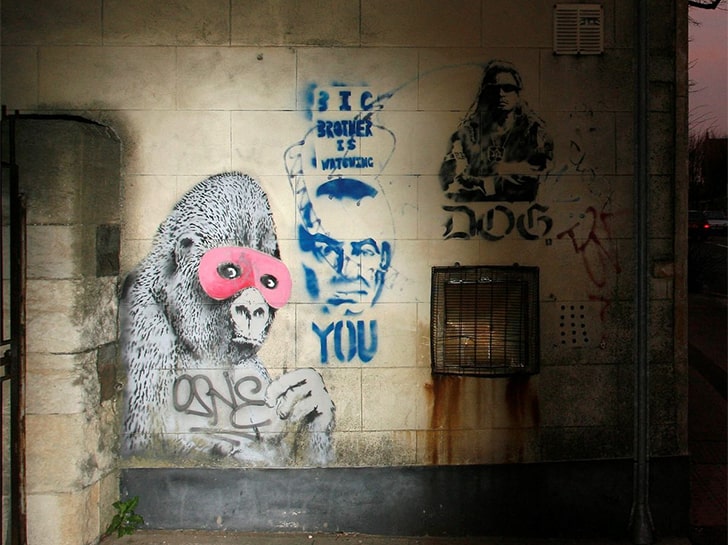
Let’s begin our exploration of Banksy’s work in the place where it’s widely believed he came from: Bristol. A walking tour of the English city would reveal many of his early works, including this masked gorilla painted on a former club wall that’s now a Muslim Cultural Center.
While not as complex as his following works, this early stencil is just as attention-grabbing. Then in his late 20s, Banksy might not have been trying to deliver a message with the image itself, but its subsequent removal and sale would be a recurring theme in his works’ fate.
Kissing Coppers - 2004, The Prince Albert Pub, Brighton
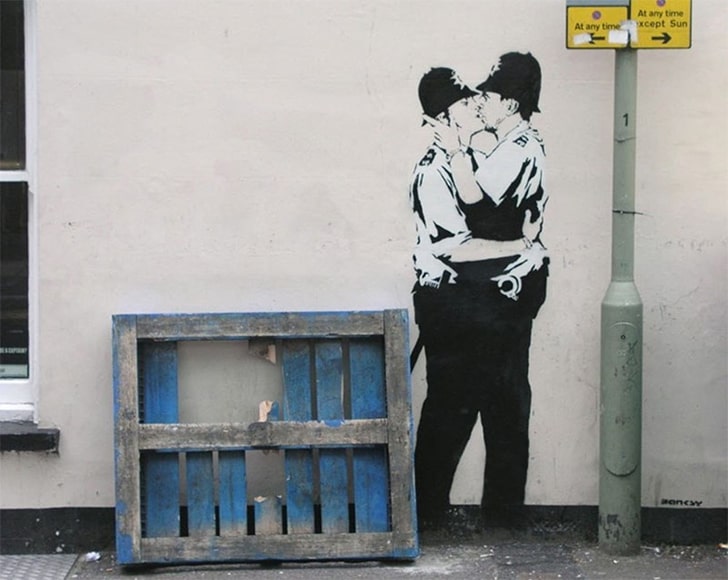
It didn’t take long before Banksy began putting out thought-provoking art, though. In 2004 he created Kissing Coppers, a mural of two policemen kissing. The meaning behind the work can be interpreted in many ways. With the English street artist having a track record of conflict with the police, it might have been one way for him to portray them beyond the macho stereotype.
On the other hand, it could also have been a statement against homophobia. After all, Brighton is considered to be the LGBT capital of the UK. Banksy would also, later on, be known for art that seemingly speaks for marginalized groups.
Girl With Balloon - 2002, Waterloo Bridge, London
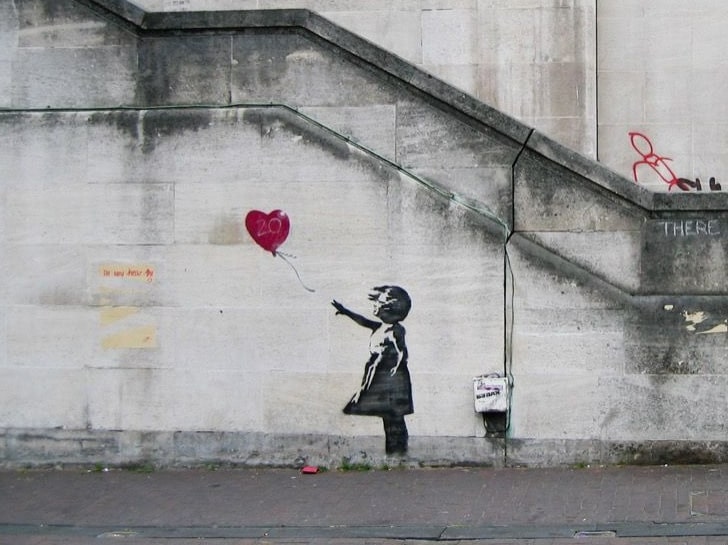
Further proof of Banksy’s way of giving the voiceless a platform is the reiterations of one of his most iconic images: Girl With Balloon. When he first came up with the stencil in 2002, he might not have had a political protest in mind. The piece is rather simple. A girl in a dress extends her hand toward a heart-shaped red balloon.
The original image also bore the inscription “There’s always hope.” That said, it’s no surprise that Banksy used a variation of the same concept when he tagged the West Bank barrier in 2005 and commemorated the third anniversary of the Syrian civil war in 2014.
Love Is In The Bin - 2018, Sotheby’s, London
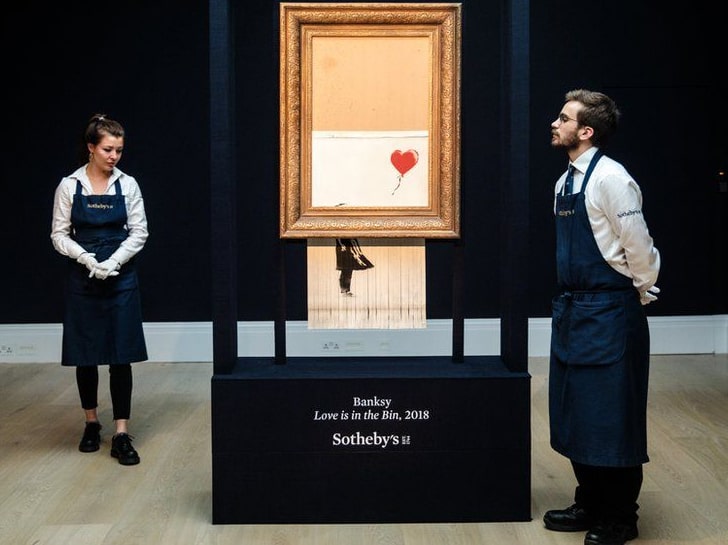
Girl with Balloon made headlines again in 2018 when it shredded itself after fetching $1.4 million at a Sotheby’s auction. Perhaps Banksy, who seems to stencil his art under the cover of night, wanted to show everyone a glimpse into his process by creating Love Is In The Bin, the tattered aftermath of the original, in front of everybody.
Not one to comment much on his works; he only addressed the incident through an Instagram video post showing the installation of blades in the painting’s frame that was done years before the auction. His only statement was a Pablo Picasso quote saying that destroying something is also a creative urge.
Sweep It Under the Carpet - 2006, Chalk Farm, London
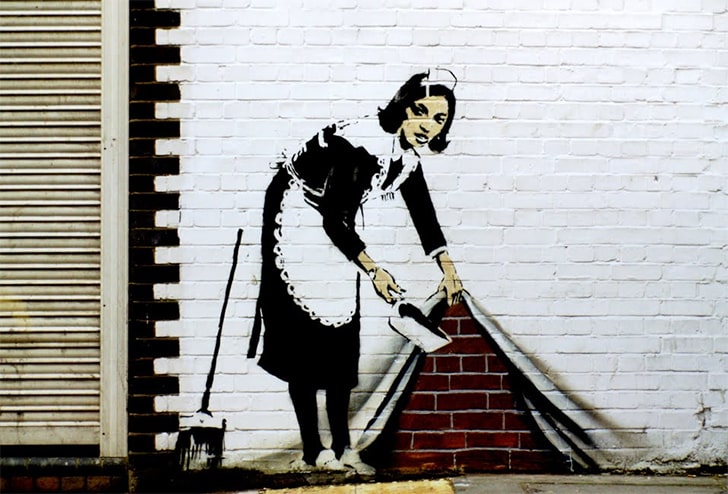
Another time Banksy shared something about his creative process is when he unveiled Sweep It Under the Carpet in 2006. The stencil features Leanne, a feisty motel housekeeper he encountered in Los Angeles. He featured her, saying that it was usually “popes and princes” who can afford to have portraits.
That wasn’t the only message, though. Some interpreted it as the government’s neglect of tackling serious issues like the AIDS crisis in African countries. The artwork was also repurposed and juxtaposed with a Damien Hirst painting and sold for $1.87 million.
One Nation Under CCTV - 2008, Newman Street, London
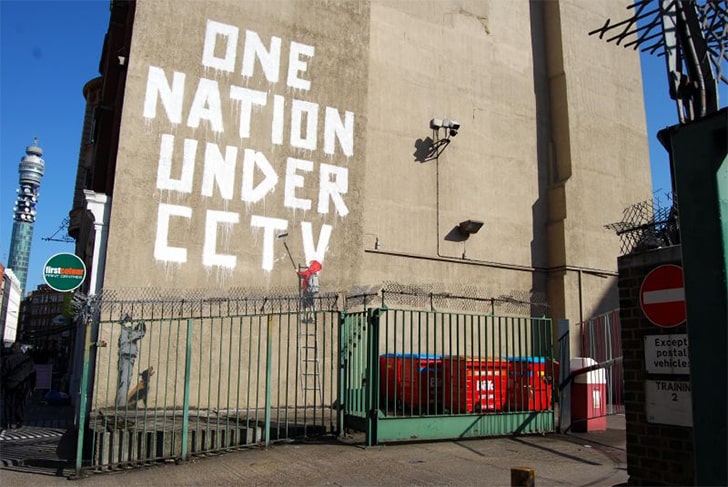
Banksy would go on to make clearer political statements, though. With One Nation Under CCTV, he took a dig at Big Brother and the prevalence of surveillance camera use in his home country. Wire estimates that over 5.9 million cameras kept watch of British people’s every move in 2015.
Interestingly, though, Banksy veered off his modus operandi of creating without permission by informing the Royal Mail of his plans. Working with scaffolding for almost a week, he unveiled the work perfectly painted beside some CCTV cameras.
Slave Labour - 2012, Wood Green, London
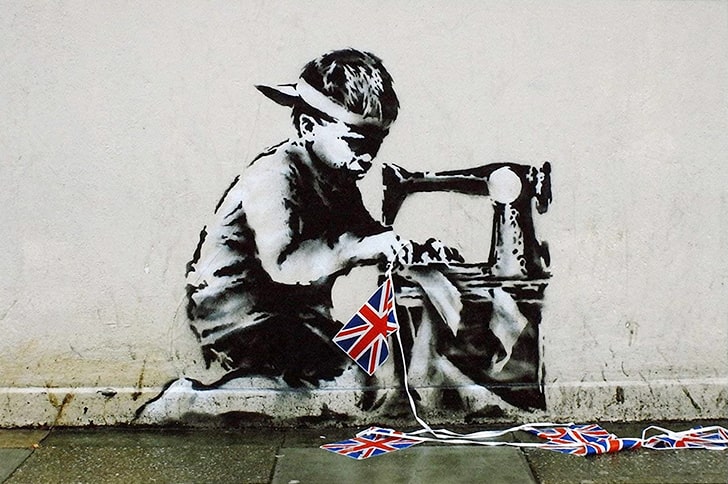
For a person who goes to great lengths to hide his identity, Banksy sure loves working with the world’s eyes on him. When the Summer Olympic Games arrived in London in 2012, he wasted no time to use his art to shed light on important issues. One of his most notable works in this period is the mural Slave Labour.
It features a young boy sewing a Union Jack flag, which is interpreted as a critique of child labor practices. An estimated 260 million children are employed in various work forms, according to the ILO. The message is definitely in line with Banksy’s anti-consumerist views, which often feature in his works.
Grin Reaper - 2004, Old Street, London
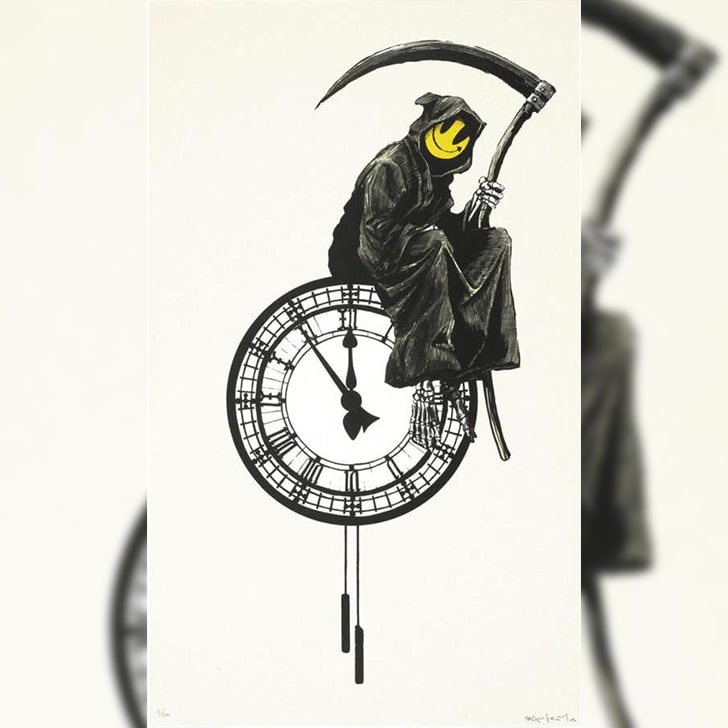
Another work that can be interpreted to have an anti-consumerist meaning is Grin Reaper. Banksy’s interpretation of the popular image of death is unique due to his use of a yellow smiley face instead of a skull. Some observe how Walmart used a similar smiley face before switching to its current logo.
If making a statement against capitalism was Banksy’s true intent, then he’s probably disappointed to see Grin Reaper knockoffs being sold on sites like eBay. He did make a buck off of the design, too, though, when he released limited edition signed copies in 2005.
Falling Shopper - 2011, Bruton Street, London
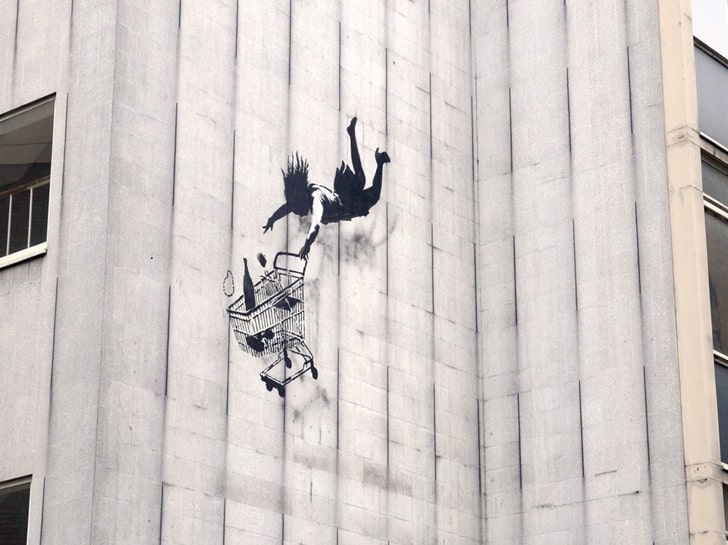
Falling Shopper is, without a doubt, a more direct attack on consumer culture. Stenciled high above the ground on the wall of an office building, it’s a play on the phrase “shop ‘till you drop.” Its placement in the high-end shopping district of Mayfair makes his message even stronger.
As a result, the mural is one of the best-preserved works in his portfolio. Perhaps Banksy has finally had enough of his work being removed, stolen, and defaced while on the street. We guess so because pulling off Falling Shopper probably would’ve involved him scaling the wall.
Well Hung Lover - 2006, Park Street, Bristol
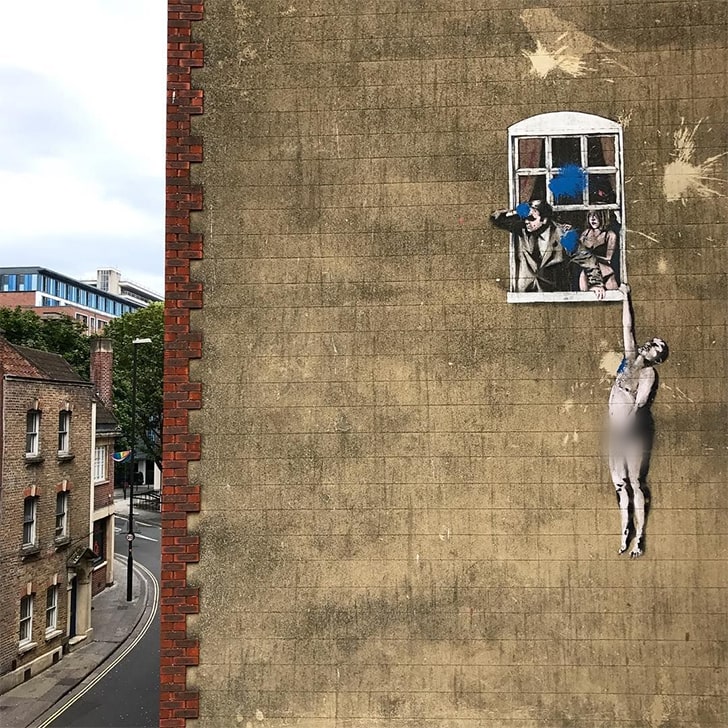
Banksy’s location choices can be humorous, too. Take Well Hung Lover, for example. The stencil, which features a hanging man seemingly hiding from his lover's spouse, was created on a reproductive health clinic wall. People have come up with many interpretations of the work.
Some compare the husband’s turning away as people’s tendency to purposefully ignore relationship problems to keep a partner. Or maybe this is a rare occurrence of Banksy letting us into his personal life. It would definitely be interesting to know which figure—the husband, the wife, or the lover—he identifies with the most.
Drunk Mickey - 2011, Sunset Boulevard, Los Angeles
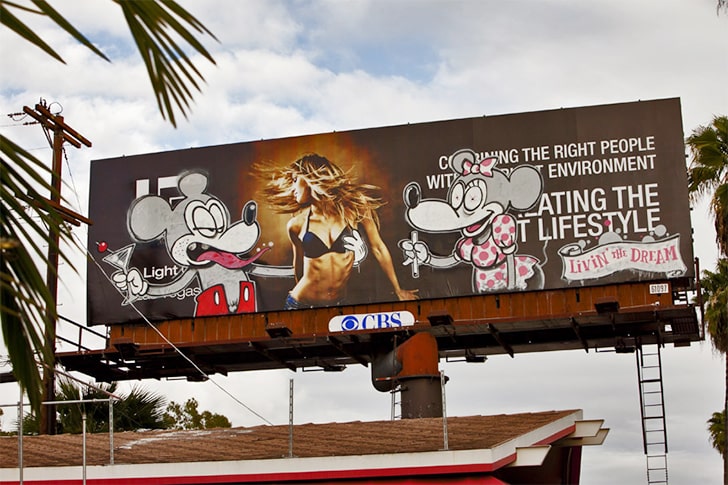
Banksy’s ability to make people think isn’t limited to his home country. He got on a plane and headed to Los Angeles in time for his film Exit Through the Gift Shop’s Oscar nomination. And he had no qualms using popular American imagery to create his often satirical art.
He scaled a billboard on Sunset Boulevard and stenciled a drunken Mickey Mouse and a Minnie Mouse seemingly high on drugs. The piece seemed to show what the British export really thought of the glitzy City of Angels. And while he didn’t win an Oscar that year, he definitely went home with more American fans because of the work he left behind.
Crayola Shooter - 2011, Westwood Boulevard, Los Angeles,
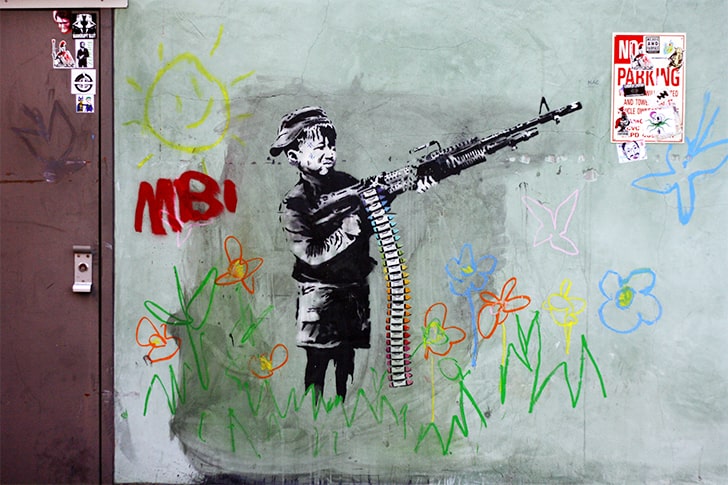
Banksy’s time in LA was productive. He also created Crayola Shooter, a stencil of an Asian boy surrounded by colorful flowers using crayons as ammunition. The work was a commentary condemning the use of child soldiers. UNICEF estimated that a quarter of the world’s child soldiers serve in East Asia and the Pacific region.
By now, you might have noticed how Banksy uses the imagery of children in his stencils. Here, he seems to be demonstrating how war can rob kids of their childhood. But he also taps into his inner child when he works on murals with more whimsical and innocent themes.
Hammer Boy - 2013, Upper West Side, New York City
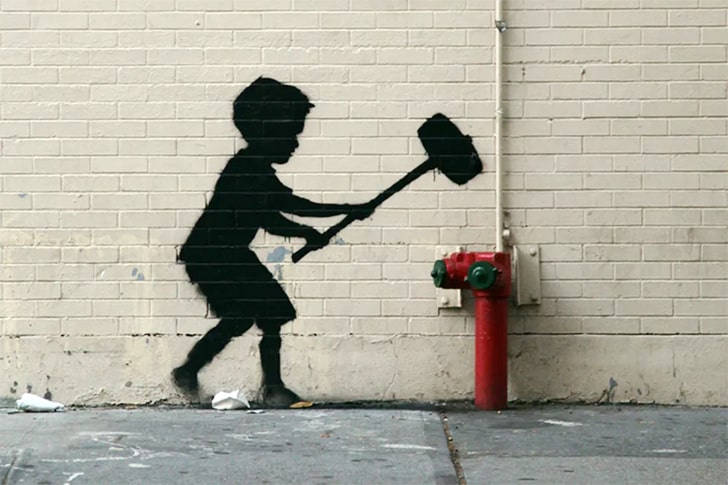
Here's a playful stencil of a young boy hammering down a fire hydrant in New York City. Part of his month-long residency in 2013, this specific one may not be alluding to a political message but a more lighthearted one as his unveiling of his Big Apple works became a sort of scavenger hunt for his fans.
For every day of his stay, the elusive artist would post a photo of his new work on his Instagram and website. Being in a part of town known for its affluence, the graffiti might seem out of place but was eventually preserved by the DSW store it was stenciled on.
Umbrella Girl - 2008, Marigny, New Orleans
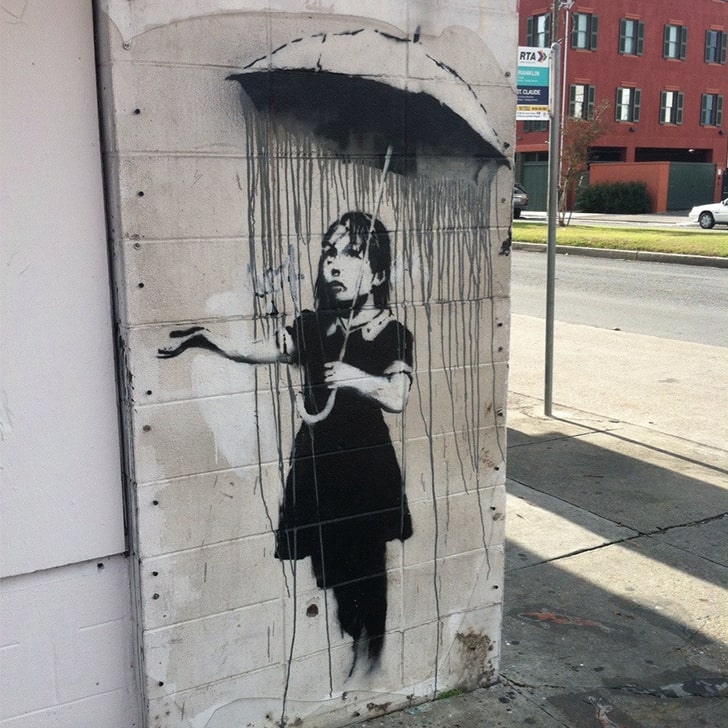
Hammer Boy isn’t the only Banksy kid in America. Down in New Orleans is Umbrella Girl, sometimes called Rain Girl. The black and white graffiti features a little girl in a dress holding an umbrella. What makes it interesting, though, is that the rain falls within her parasol instead of outside.
The piece references the Louisiana city’s devastating experience with Hurricane Katrina in 2005. It first appeared in 2008 as part of the Nola series of murals Banksy created in New Orleans. Although not a local, he still found a way to uplift Americans in the wake of one of the costliest storms in the country’s history.
Follow Your Dreams - 2010, Chinatown District, Boston
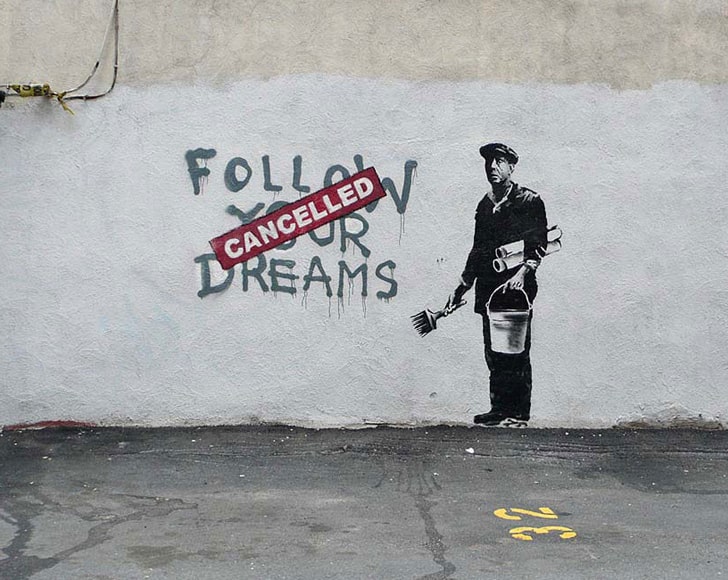
But Banksy’s sympathy also took the form of critique of US society. See his mural Follow Your Dreams painted in 2010. The work seems to comment on class stratification and how it hinders certain people from achieving the coveted “American Dream.”
While we don’t know what kind of economic background Banksy comes from, he surely shows awareness of the less fortunate's struggles in life. You’d find it interesting, though, that a report from The Critic alludes to the possibility of Banksy coming from a more affluent background than implied by his original story.
Let Them Eat Crack - 2008, SoHo, New York City
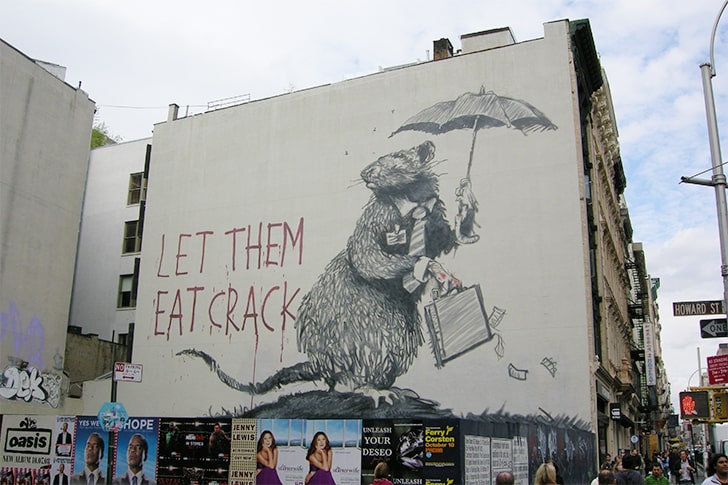
If that’s true, then his biting commentary on Wall Street and its views of the middle and lower classes become more interesting. Here’s a man who supposedly grew up with money condemning the rich for ignoring the plight of the poor, more specifically, American society’s persistent problem with the prevalence of drugs.
Let Them Eat Crack is his version of the famous quote “Let them eat cake,” usually attributed to Marie Antoinette addressing French peasants. The mural features a large rat in business attire, turning away with a suitcase full of cash. This leads us to another observation: Banksy’s constant use of rats in his work.
Rat With Box Cutter - 2018, Centre Pompidou, Paris
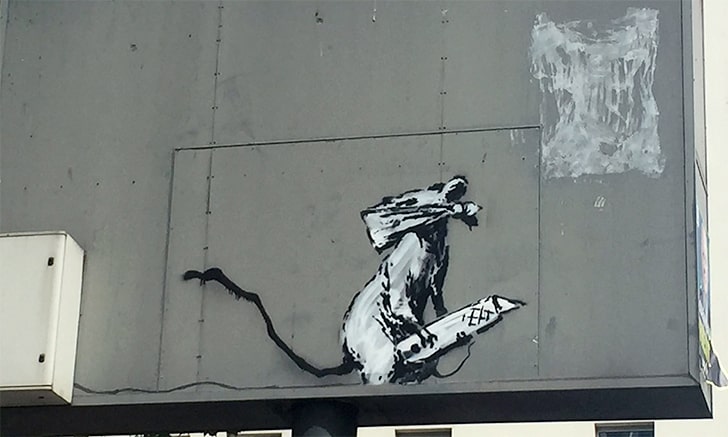
The anonymous provocateur’s fascination with rodents started early in his career, as Smithsonian magazine observed in their profile of Banksy. He even took them on his trip to Paris in 2018. Paying tribute to the French street artist Blek Le Rat, dubbed as the father of stencil graffiti.
This fact isn’t lost on Banksy, who posted a photo of the rat holding a box cutter graffiti with a caption recalling Paris 1968 as the birth of modern stencil art. The late ‘60s was a period of civil unrest and uprisings in the City of Lights. This isn’t the first time the British artist paid tribute to a Frenchman.
Show Me The Monet - 2005, Canvas, London Studio

In 2005, Banksy recreated Claude Monet’s Bridge Over a Pond of Water Lilies and gave it a modern twist. Called Show Me the Monet, the reimagined masterpiece shows the same tranquil pond polluted with shopping carts and a traffic cone. The painting touched on Banksy’s favorite topic of consumerism, but this time with a touch of environmentalism.
It’s interesting to note, though, that the piece sold for £7.6 million ($9.8 million) in October 2020. After Devolved Parliament, it’s the second most expensive Banksy work ever sold. We wonder if any of those millions went to him, though, as he sold it during his 2005 exhibition.
Girl Covers Swastika - 2018, Porte de la Chapelle, Paris
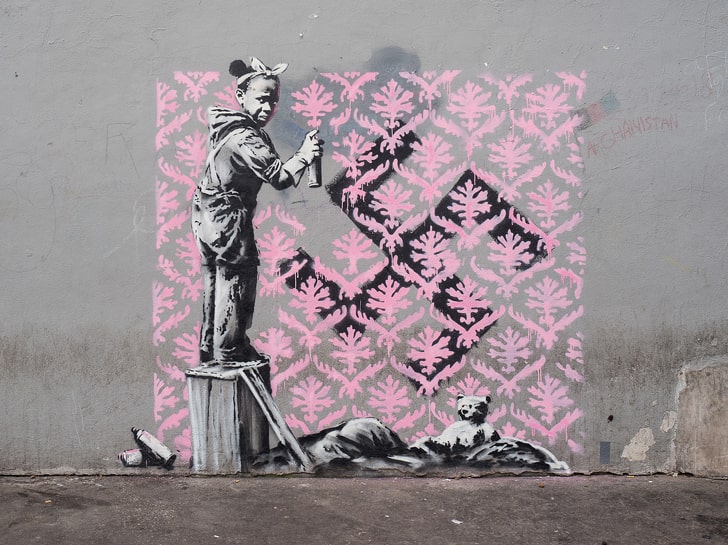
Going back to Banksy’s time in Paris, he definitely made good use of his stay there. On the occasion of World Refugee Day, he unveiled a powerful graffiti of a girl of African descent spray painting over a Nazi swastika symbol. Its placement makes the message clear, being painted on the wall of a refugee center that the French government closed down.
The move was seen by many as President Emmanuel Macron, who France24 described as a right-wing president, cracking down on migrants in the European nation. With the UK being close neighbors with France, it isn’t surprising that Banksy is well aware of what’s been going on there.
Banksy’s Veiled Napoleon - 2018, Passage de la Main d'Or, Paris
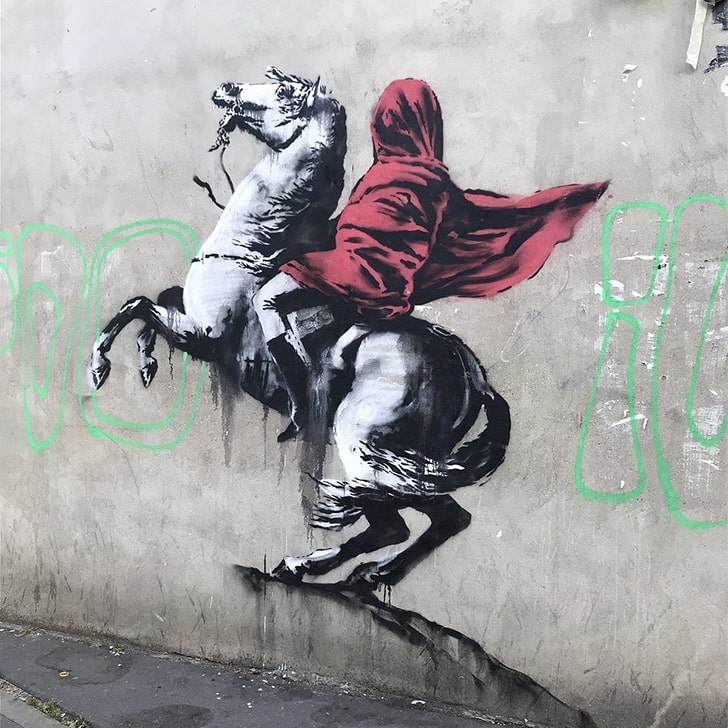
Ever the prankster, Banksy also showed some humor in his work in Paris. Here’s his take on Jacques-Louis David’s Napoleon Crossing the Alps. An iconic image to the French, he gave it a twist and covered the historical figure’s face. Some say that detail is about a 2010 ban on the public wearing of face coverings in France.
Meanwhile, others see it as Banksy’s way of criticizing the French government’s use of propaganda to blind its people in a misguided attempt to lead them. Since he’s not one to fully explain himself, we’re left to make our own interpretations of the work. How about you, what do you think?
Every Picture Tells A Lie - 2003, Künstlerhaus Bethanien, Berlin
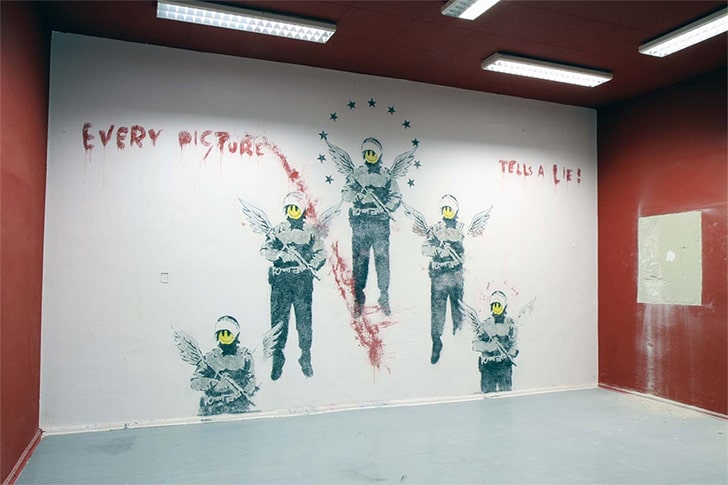
Banksy’s art in mainland Europe isn’t just confined to Paris. In 2003, he created the mural Every Picture Tells a Lie as part of a curated street art project. Unlike his work in France, though, he had more time to create this piece without the pressure of evading potential arrest. Thus, it has more detail, most notably his use of yellow smiley faces again.
Featuring police in riot gear and fitted with angel-like wings, the large scale stencil follows a similar theme with Banksy’s other works criticizing violence and authority. This kind of message would also be present in his next overseas project.
Rage, Flower Thrower - 2005, Jerusalem, Israel
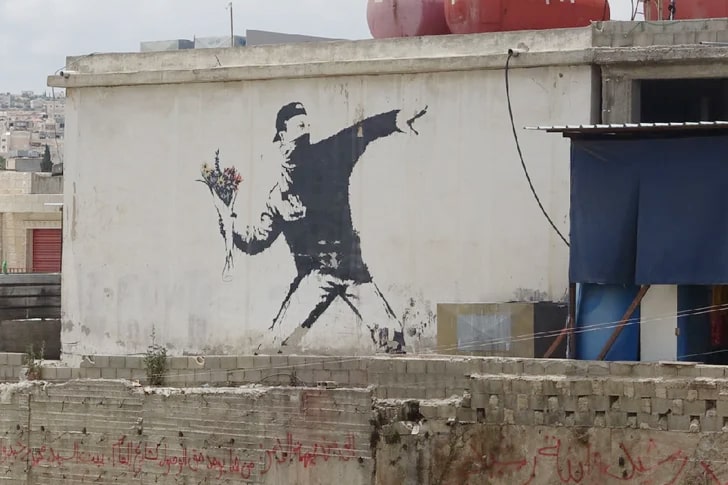
Smithsonian Magazine credits Banksy’s time in Israel for turning him into an international star. Coming to a place where he could make the most impactful statements on war and peace, he probably felt immense pressure to deliver. Fortunately, he did.
He unveiled one of his most famous stencils, Rage, The Flower Thrower, also called Love is in the Air. Said to be inspired by a Judyth Hill poem, the image encourages people to choose peace over war or “wage peace,” as the poem says. This is shown in Banksy’s choice to put flowers instead of something harmful in the protester's hand.
Balloon Debate - 2005, West Bank Barrier, Israel

Another mural he created while there is Balloon Debate. Stenciled on the West Bank barrier wall separating Israel and Palestine, the mural depicts a Palestinian girl’s hope to fly over the concrete wall to freedom. As before, Banksy is using the imagery of children to expose the brutalities of the world.
And he did so at great risk, we imagine. No art degree comes with classes teaching you how to scale a 25-foot-tall wall in the presence of the military while trying not to blow your cover. Jumping through many hoops for his art, we don’t doubt that Banksy believes in the messages he sends out to the world.
The Walled Off Hotel - 2017, Bethlehem, Palestinian Territory
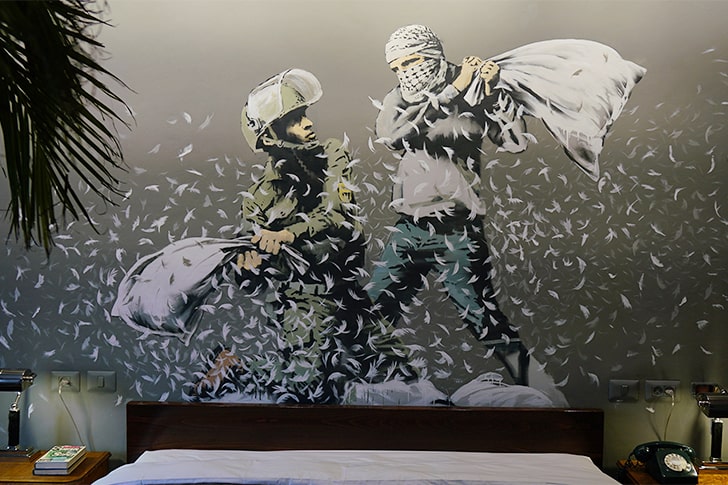
But it seems like no challenge is too great for Banksy. Returning to the West Bank wall in 2017, he put up a boutique hotel, The Walled Off Hotel, which was really an exhibit and protest space. We have got to commend him, though, for making the establishment fully functioning.
And true to his anti-capitalist views, he didn’t make a buck off the project as locals own the place, and its profits went to local projects, too. Don’t feel too bad about missing out on this one, though. The experience at the hotel with the “worst view in the world” (Hint: It’s the wall.) isn’t meant to be fun.
Elephant In The Room - 2006, Barely Legal Exhibition, Los Angeles
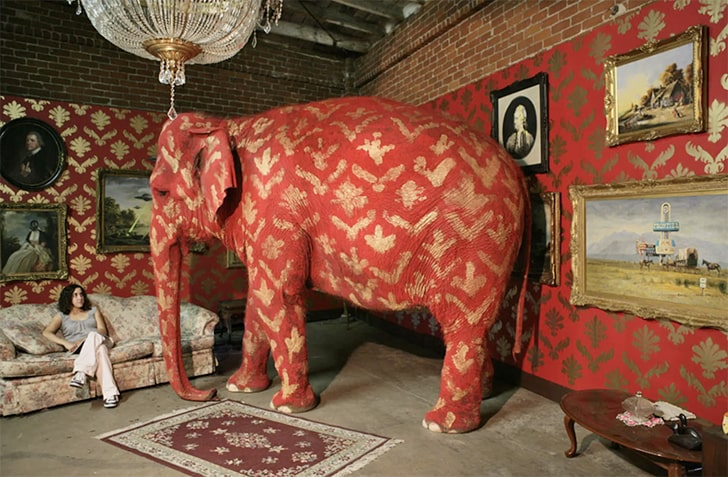
As you just saw, Banksy’s art can’t be contained on random street walls alone. Shortly after his first trip to the Middle East, he went to Los Angeles for his Barely Legal exhibition. You can say this was a prolific period in his career. The real star of the show is the elephant, Tai.
She wasn’t just any elephant, though. She was painted all over with pink and gold paint, non-toxic of course, to match the wallpaper. Banksy literally put the elephant in the room to highlight a problem people don’t want to talk about: world hunger. The local animal protection services department wasn’t too pleased, though.
Dismaland - 2015, Weston-super-Mare, Somerset
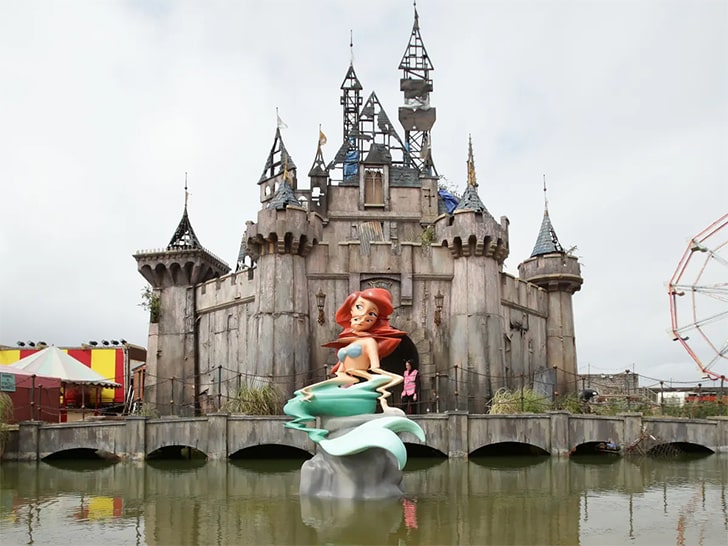
Another impressive Banksy production is Dismaland. And yes, it was every bit the dreary version of Disneyland you imagine it to be. It was built on an unused public resort, and it opened complete with a derelict castle, trippy Disney imagery, and an unwelcoming staff to boot.
Banksy got a little help from 58 artists to pull it off. After all, the phantom celebrity is but human at the end of the day. The attraction was only open for over a month. And just like with The Walled Off Hotel, you’d be better off staying at a top hotel than here.
Guantanamo Bay - 2006, Disneyland, Los Angeles
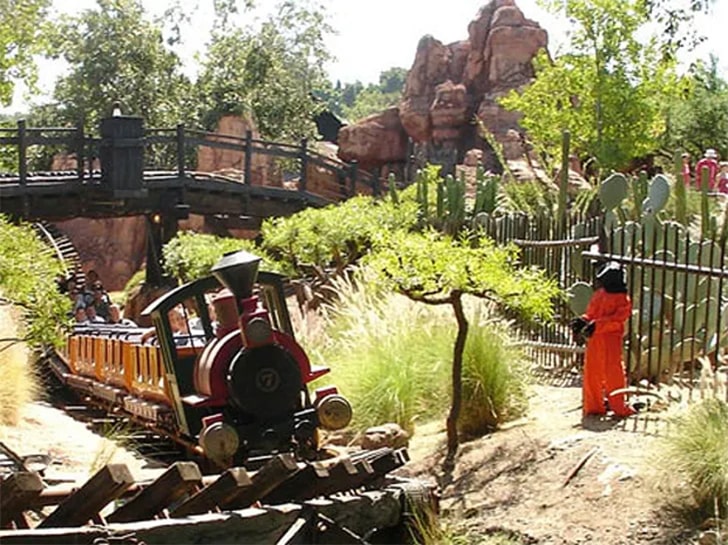
It seems like Banksy’s obsession with Disneyland is a longstanding one. In 2006, he did something not many people can do. He shut down a park ride. It’s all thanks to his placing of a replica of a Guantanamo Bay prisoner inside the vicinity of the Big Thunder Mountain Railroad ride.
The figure in orange stood there for a whole 90 minutes before it was removed. As for Banksy, he escaped capture by changing his clothes in a restroom. While we’re glad he got away just in time, can you imagine how close the world was to unmasking the anonymous artist?
Napalm - 2004, Canvas, London Studio
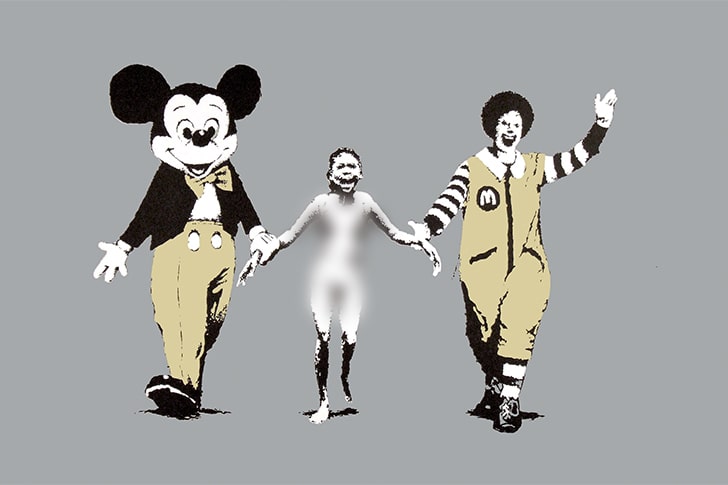
Of course, Banksy doesn’t always have to do big stunts to make a statement. He proved that with his early painting Napalm, also called Can’t Beat That Feeling. The piece uses the injured figure of Phan Thi Kim Phuc after a napalm attack, as seen in the famous Pulitzer-winning photograph.
His version shows the distressed girl hand-in-hand with Mickey Mouse and Ronald McDonald. The use of two American pop culture characters makes Banksy’s painting an obvious critique of America, who participated in the Vietnam War. Some people saw it as a comment on the way the US treated the Vietnamese during the conflict.
Devolved Parliament - 2009, Canvas, London Studio
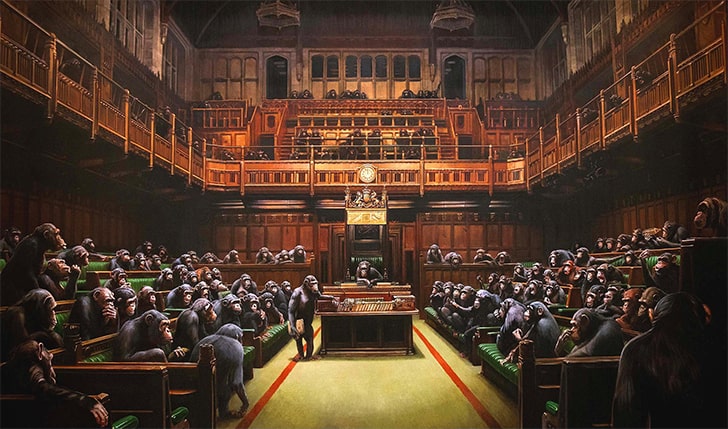
Another impressive canvas work by Banksy is Devolved Parliament. The piece notably depicts the British parliament as a bunch of apes painted in the Victorian style. Aside from its timeless and biting political commentary, there’s another reason why this massive artwork made the news.
It’s currently the most expensive Banksy work ever sold. It was auctioned for $12.1 million in 2019. Some doubt whether the street artist was really the one who created it, though, questioning the skill it demonstrates compared to his other works, which are most often stenciled.
Game Changer - 2020, Southampton General Hospital, Southampton
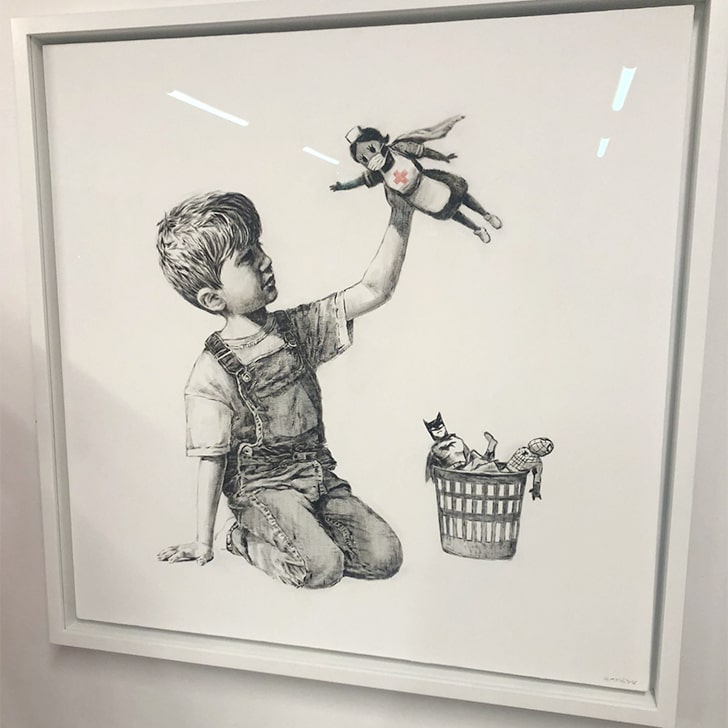
But for all Banksy’s harsh criticism of his home country, it’s still evident that it has a place in his heart. One of his latest works, Game Changer, is a tribute to the British frontline workers that have been toiling through the pandemic. He unveiled the uplifting piece in May 2020.
What’s even more touching is that he put the work up for auction to benefit the NHS. Some describe Game Changer as an uncharacteristic piece from the usually satirical Banksy. Still, it’s a welcome one during these times. What’s an artist for but to comfort the disturbed, too?
